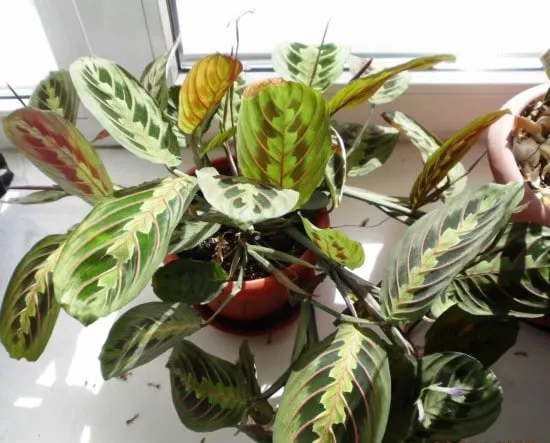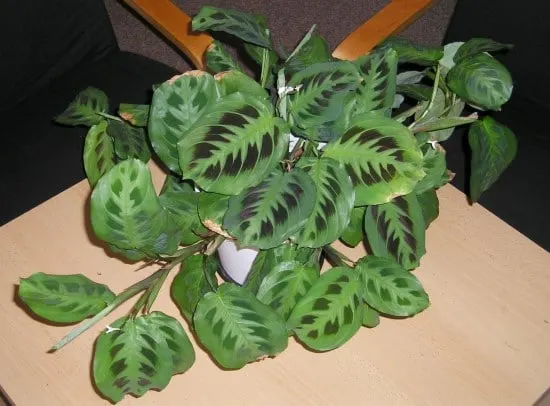The prayer plant, also called Maranta Leuconeura is an inhabitant in South America. It belongs to the Marantaceae family and is well-known for the flat leaves of different colors that fold at night and look like praying hands.
Prayer plants can be grown indoors throughout the year, making them good-looking annually, especially in the chilly winter months.
They grow best in conditions of high moisture, low light, and moist but well-drained soil. They produce flowers at the beginning of spring, though rarely when kept indoors. Prayer plants, also known as calatheas, are hardy outdoors in the USDA hardiness zones 11 to 12. Then, why do prayer plants move?

Why Do Prayer Plants Move?
There are several theories as to why prayer plants move, but there is no apparent consensus. We should assume that these plants have a significant evolutionary advantage; otherwise, they wouldn’t have grown in this method, but scientists can speculate.
The number of species is only a portion of all plants, so it’s hard to explain why it evolved in several plant species.
Since the prayer plant opens its leaves in the daytime and folds at nighttime, they are likely to regulate their movements. Also, they control the amount of sunlight absorbed by the leaves for the precise daytime hours.
So why do they fold up at nighttime? According to one theory, the folding function prevents rain or dew from accumulating on the leaves in the cold at night and prevents the formation of fungus on the leaves’ surface.
Other evolutionary benefits of prayer plant movement include temperature control and nighttime protection from insects or animals. We can only imagine the real reason for this sole habit, but part of the habit of these plants is a mystery.
When Do Prayer Plants Move?

The movement of prayer plants follows the circadian rhythm, as do the sleep or wake phases of animals, humans, and many other plants.
Typically, this rhythm is not linked to daytime but the presence or lack of light. A prayer plant can be influenced to move by placing it in a dark room or offering light for growth.
Many people talk about nocturnal changes: from the flat leaves on the horizontal stalks to tall stalks and vertical or raised leaves.
Nevertheless, this transformation is gradual than at sunrise because the morning light penetrates through the window, and the upright leaves flatten out or dropdown.
Sometimes you see so-called nocturnal prayer plants because they seem to be most active at night. Plants cannot be nocturnal or diurnal, as these terms correspond only to animal behavior.
The leaves move much more during the daytime than at night. Once they’ve reached the upright night position, they’ll stay there more or less until dawn.
Plus the change seen at sunset and sunrise, the leaves of prayer plants continually change their position all day long as the leaves’ angle and the amount of light change.
Even though the movement is generally very slow to be seen with a single glance, the difference in position can be seen by taking pictures from a similar angle throughout the day and then comparing them.
Some heard the roar of this plant in moving or saw an abrupt change in the leaf’s position. This is not true because the vegetation moves quickly, but a single leaf is lying on the peak or alongside another.
As they progress, a point is created where the trapped leaf fails to resist the force of gravity and go into place.
Who Should Grow the Prayer Plant?
Prayer plants are the indoor plants that are relatively easy to care for. They can be planted in larger containers or hanging baskets.
Also, they spread wide and low, allowing their lush leaves to beautify your home and purify the air as it grows. Prayer plants prefer moist conditions and dry soil. Although they favor a tropical environment, they are worthwhile to grow and don’t need a lot of attention.
The plants have attractive leaves. Typically, they are hardy houseplants that usually grow tall relative to planting spaces, unlike related houseplants that require continuous planting or planting.
Prayer plants have different leaves, but they don’t produce spectacular blooms, making them a good choice for modest ornaments.
>> Check More Indoor Plants:
- 10 Amazing Easy Care Indoor Plants to Beautify Your Home
- 39 of the Cutest, Small Indoor Plants You Can Grow in Any Season
- 19 of the Amazing Indoor Hanging Plants – Beautify And Clean Your Home
What is Done If the Prayer Plant Does Not Move?
1. Check the intensity of the light
If the prayer plant is not moving, you must first assess the lighting. Because weeds react to light and dark, they may move slowly if the light is stable.
For instance, if you put this plant under grow light without changing its location or the quantity of light received by the plant, it is unlikely to move. Light and dark stimuli cause the position of the leaves to change.
Prayer plants, which do not get enough light, do not move the leaves at night. Keep the leaves open and flat because they absorb as much light as possible during the day. These plants love indirect light filtered, but they suffer when the room is very dark.
2. Water thoroughly
A thirst prayer plant can move little or not. Since we recognize that the mechanism of leaf movement is associated with specific water-filled cells, it makes sense for a plant to refrain from this movement if not enough moisture is available.
When the soil is dry and leaves look wrinkled and flabby, it is time to water. Also, the dry leaves can develop crisp brown edges.
3. Could the plant be in shock?
This is the most likely offender if you have recently replanted your prayer plant. This plant is quick to respond to unexpected changes in the environment, including moving to a larger pot.
Some owners of the prayer plant realize that their plants stop or significantly slow down movement in the weeks once they repotted. If the plant looks healthy, give it time to adjust, and it will be back to normal soon.
Conclusion
The prayer plant is attractive and also offers a fascinating insight into the botanical secret. It requires more attention than other houseplants but rewards the focused owner with stunning leaves as the plant changes and moves. There are many reasons why prayer plants move, and this article has given the key reasons.
